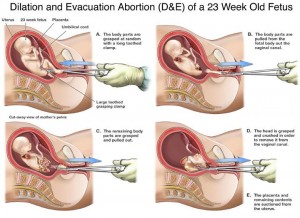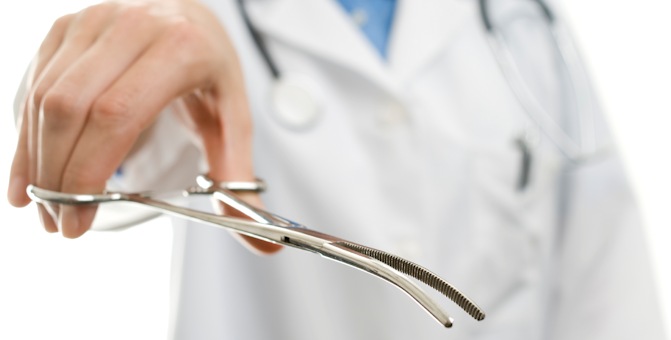Kansas Governor Sam Brownback has signed the nation’s first law banning D&E abortion procedures. These abortions are typically performed during the second trimester, and rip preborn babies apart limb by limb.
This is why, across the nation, similar proposed laws are being referred to as “dismemberment bans.” It may be blunt, but it is terribly accurate, and despite the claim by the Associated Press, there’s no “redefining” going on here. D&E abortions have always been performed by dismembering the preborn baby.
Kansas’ dismemberment ban calls it like it is.

Kansas Governor Sam Brownback
From the Associated Press:
“This is a horrific procedure,” Brownback spokesman Eileen Hawley said. “He hopes the nation follows suit.”
The procedure is banned except when necessary to save a woman’s life or prevent irreversible damage to her physical health. Doctors cannot use forceps, clamps, scissors or similar instruments on a fetus to remove it from the womb in pieces.
Pro-abortion activists are fighting not only against the passage of the ban, but against the name itself. They strongly object to such laws being called “dismemberment bans.” Yet, descriptions by abortion proponents, such as late-term abortionist Warren Hern and the National Abortion Federation, set the record straight.
There is no actual dispute about whether or not D&E abortions dismember living human beings.
From abortionist Warren Hern:
It is better to use smaller forceps and take smaller amounts of tissue each time than to deliver fetal parts intact while traumatizing the cervix…
At 16 to 17 weeks, fetal tissue is much more easily identifiable with the forceps and in some ways is easier to grasp and remove than in earlier gestations. The [skull] is about the size of a Ping-Pong ball and usually can be grasped readily with the Bierer. Collapsing it gives a definite sensation…
At 18 to 19 menstrual weeks… fetal parts are significantly larger and more difficult to morcellate(tear into pieces)… [Abortion after the] 20-week gestation… can be a significantly more difficult procedure accompanied by unnerving hemorrhage.
Forceps use must be sure and relatively rapid. There is frequently not much time for exploring the nuances of different tissue sensations. Grasping and collapsing the [skull is] often difficult.
Stripping the [skull] of soft tissue is sometimes the first step in successful delivery of this part, followed by dislocation of parietal bones. In this case, care must be taken in removal because ossification is occurring and the edges are sharp…
Regardless of the amount of dilatation, delivery of the [skull] and pelvis is sometimes difficult… The advantage obtained by having a softened cervix could become a disaster if a laceration develops at the level of the internal os as the result of too much force…
The procedure changes significantly at 21 weeks because the fetal tissues become much more cohesive and difficult to dismember. This problem is accentuated by the fact that the fetal pelvis may be as much as 5 cm in width… [The skull] can be collapsed. Other structures, such as the pelvis, present more difficulty… A long curved Mayo scissors may be necessary to decapitate and dismember the fetus, since it may be impossible to apply forceps or to do so while avoiding the thinned-out cervix.

D&E Abortion Procedure via NRLC.
Here are the National Abortion Federation’s actual instructions on how to perform a D&E abortion:
Once the forceps has passed through the internal os, open the jaws as widely as possible to encircle the fetal tissue and avoid pushing fetal parts deeper into the fundus… After 16 weeks’ gestation, fetal skeletal development is such that the surgeon can manually sense the presence of fetal parts within the closed jaws… After grasping a fetal part, withdraw the forceps while gently rotating it. This maneuver brings the fetus into the lower uterine segment before the grasped fetal part is separated (if necessary) and removed from the cervix…
If a fetal extremity is brought through the cervix without separation, advance the forceps beyond the extremity to grasp part of the fetal trunk. Bringing the fetal trunk into the lower segment markedly reduces the number of instrument passes into the fundus… During the procedure, try to identify and keep track of fetal parts as they are removed. A “pouch’ or surgical pan at the edge of the gable to catch fetal parts can assist this process.
Americans need to hear and fully realize the facts about abortion. It’s not a simple or painless procedure. It’s complicated, tragic, and cruel – no matter how it’s performed. Kansas is leading the way, and forcing our nation to have a real discussion about what abortion really is.
Read more facts about D&E abortions from a former abortionist here, and learn about fetal development at the stage when these abortions are performed here (look at three to six months).







